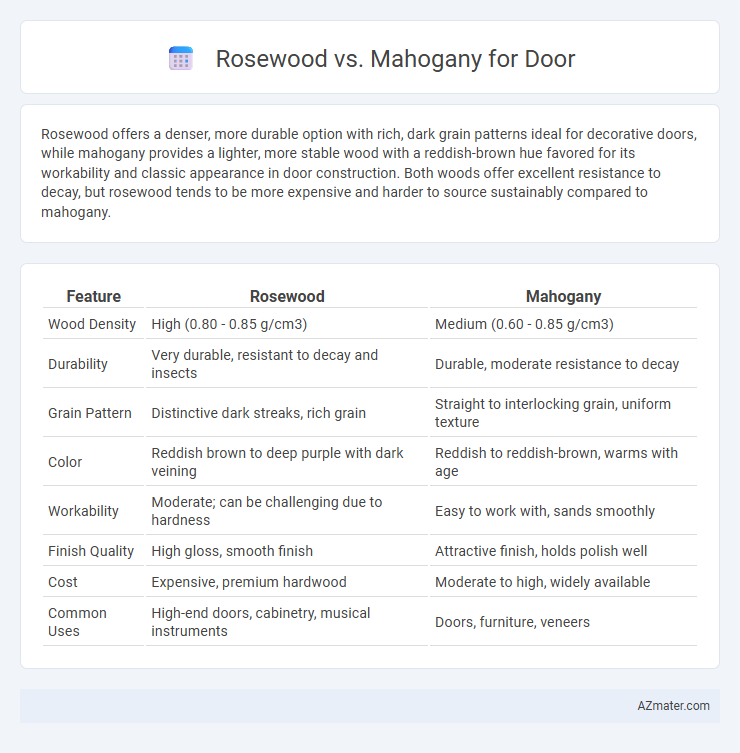Rosewood offers a denser, more durable option with rich, dark grain patterns ideal for decorative doors, while mahogany provides a lighter, more stable wood with a reddish-brown hue favored for its workability and classic appearance in door construction. Both woods offer excellent resistance to decay, but rosewood tends to be more expensive and harder to source sustainably compared to mahogany.
Table of Comparison
| Feature | Rosewood | Mahogany |
|---|---|---|
| Wood Density | High (0.80 - 0.85 g/cm3) | Medium (0.60 - 0.85 g/cm3) |
| Durability | Very durable, resistant to decay and insects | Durable, moderate resistance to decay |
| Grain Pattern | Distinctive dark streaks, rich grain | Straight to interlocking grain, uniform texture |
| Color | Reddish brown to deep purple with dark veining | Reddish to reddish-brown, warms with age |
| Workability | Moderate; can be challenging due to hardness | Easy to work with, sands smoothly |
| Finish Quality | High gloss, smooth finish | Attractive finish, holds polish well |
| Cost | Expensive, premium hardwood | Moderate to high, widely available |
| Common Uses | High-end doors, cabinetry, musical instruments | Doors, furniture, veneers |
Introduction: Rosewood vs Mahogany for Doors
Rosewood and mahogany are premium hardwoods commonly used for door construction, each offering distinct aesthetic and physical properties. Rosewood is known for its rich, dark coloration with natural oily texture that enhances durability and resistance to moisture. Mahogany features a warm reddish-brown hue with a fine, straight grain that provides strength and stability, making it a popular choice for classic and elegant door designs.
Wood Origins and Botanical Overview
Rosewood, predominantly sourced from tropical regions of Brazil and India, belongs to the Dalbergia genus known for its dense grain and rich ebony-brown hues with purple or reddish streaks. Mahogany originates mainly from Central and South America, especially Honduras, and is classified under the Swietenia genus, characterized by its straight grain and deep reddish-brown color. Both woods belong to the Fabaceae family, prized for durability and aesthetic appeal in fine door craftsmanship.
Color and Grain Differences
Rosewood doors exhibit a rich, dark brown to purplish hue with distinctive, bold grain patterns featuring swirls and streaks that add visual depth. Mahogany doors display a warm, reddish-brown color with a more uniform and straight grain, providing a classic and elegant appearance. The contrasting color tones and grain textures make rosewood ideal for a dramatic statement, while mahogany offers timeless sophistication in door design.
Durability and Hardness Comparison
Rosewood exhibits exceptional durability and hardness, making it highly resistant to scratches, dents, and wear over time, which is ideal for doors exposed to heavy use. Mahogany also provides considerable strength and durability, known for its stability and resistance to decay, but it tends to be softer than rosewood, making it more susceptible to surface damage under impact. For door applications requiring maximum longevity and scratch resistance, rosewood outperforms mahogany, while mahogany offers a balance of durability with easier workability.
Resistance to Environmental Factors
Rosewood offers moderate resistance to moisture and insects, making it suitable for indoor door applications but less ideal in highly humid or variable climates. Mahogany exhibits superior resistance to rot, decay, and termite attacks due to its dense grain and natural oils, making it a preferred choice for exterior doors exposed to harsh environmental conditions. Both woods benefit from proper finishing, but mahogany's durability under extreme weather stress ensures longer-lasting door performance.
Cost and Availability
Rosewood doors typically command a higher price due to the wood's rarity and rich, dense grain, making them less readily available in the market. Mahogany offers a more affordable option, benefiting from wider availability and established supply chains that ensure consistent stock for door manufacturing. Choosing mahogany can reduce costs significantly while still providing durability and an attractive finish.
Maintenance and Longevity
Rosewood doors require regular oiling and polishing to maintain their rich color and prevent drying or cracking, offering high durability when properly maintained. Mahogany doors are naturally resistant to rot and insects, requiring minimal upkeep beyond occasional cleaning and refinishing to preserve their smooth surface and rich tone. Both woods provide excellent longevity, with mahogany typically lasting longer in outdoor settings due to its superior resistance to weathering.
Acoustic and Insulation Properties
Rosewood offers superior acoustic properties for doors due to its dense grain structure, providing excellent sound absorption and reducing noise transmission. Mahogany features moderate insulation qualities with its fine, straight grain, offering decent thermal resistance but less effective soundproofing compared to rosewood. Choosing rosewood enhances acoustic performance, while mahogany provides balanced insulation with aesthetic warmth.
Aesthetic Appeal and Design Versatility
Rosewood offers a rich, reddish-brown hue with dark veining that enhances the aesthetic appeal of doors by providing a bold, exotic look. Mahogany features a consistent fine grain and a warm, reddish-brown color that lends a classic, timeless elegance and suits traditional and contemporary designs alike. Both woods exhibit excellent design versatility, but rosewood's striking patterns cater to intricate, decorative styles while mahogany's smooth texture supports a wide range of finishes and customizations.
Best Applications and Recommendations
Rosewood offers exceptional durability and rich, dark tones, making it ideal for high-end, decorative doors requiring a luxurious finish and strong resistance to wear. Mahogany is prized for its stability, fine grain, and warm reddish-brown color, best suited for classic interior doors or exterior doors in moderate climates due to its natural resistance to rot and decay. For heavy-traffic or weather-exposed applications, mahogany's consistent strength and dimensional stability make it the preferred choice, while rosewood excels in premium, statement doors where aesthetic richness is paramount.

Infographic: Rosewood vs Mahogany for Door
 azmater.com
azmater.com